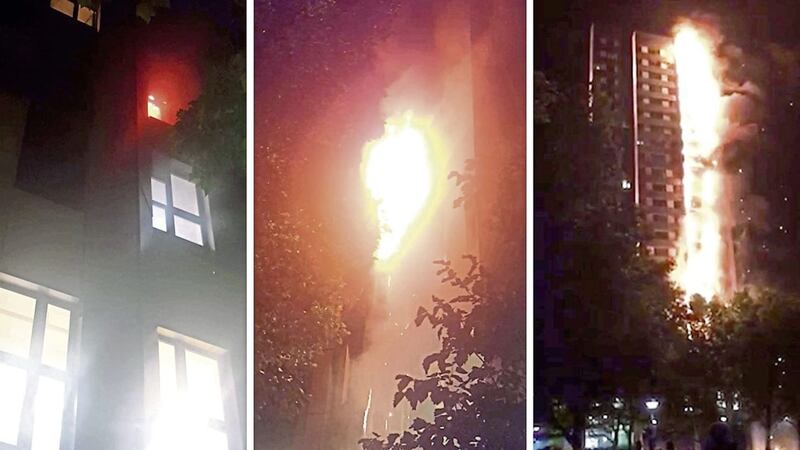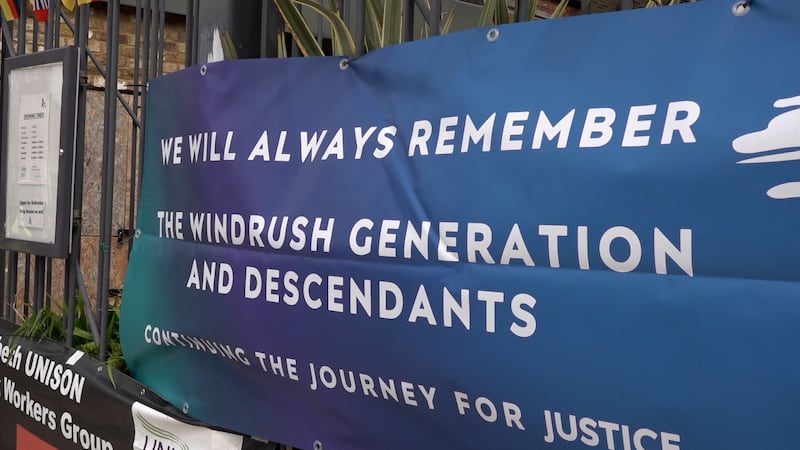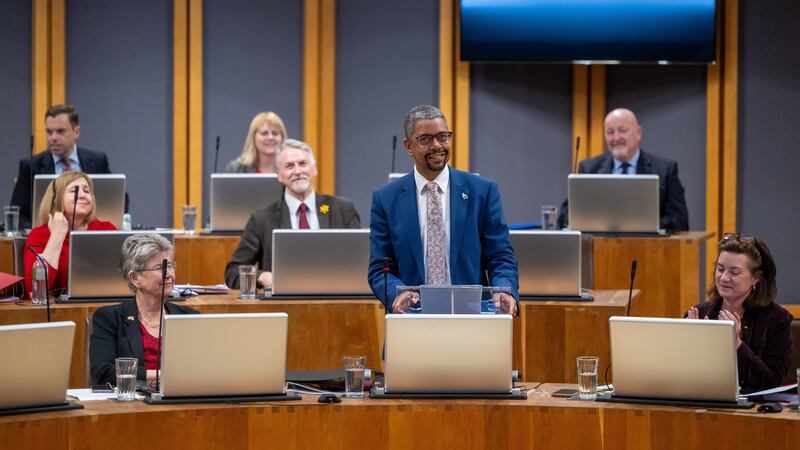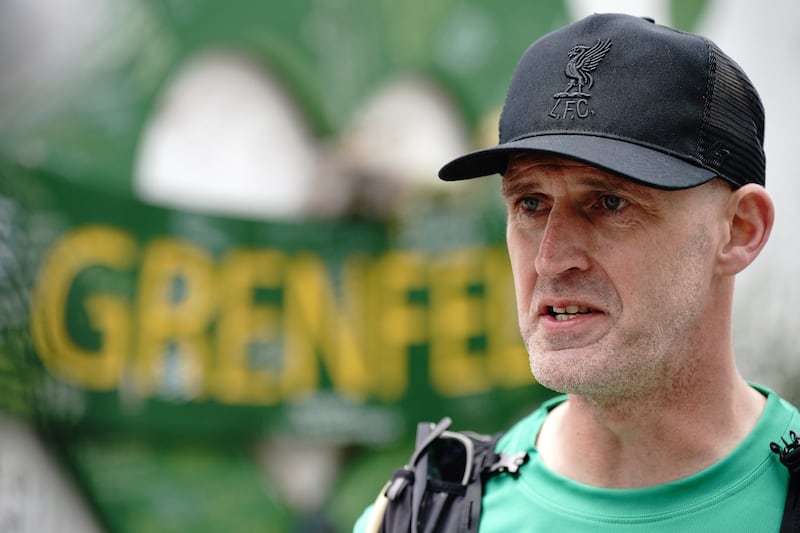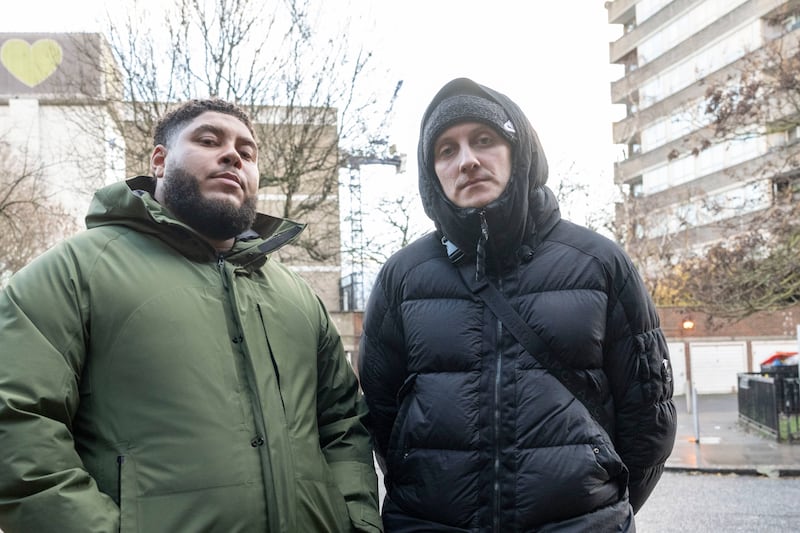A VENTILATION system intended to prevent the Grenfell Tower stairs from becoming clogged with smoke was reported to have failed just days before the deadly fire, a public inquiry document shows.
On June 6 last year, PSB, the company that designed the mechanical system, said it received an email saying a potential fault report had been made by Rydon – the main contractor on the blocks 2016 refurbishment.
The report said the automatic opening vents were not opening.
JS Wright, a sub-contactor which originally contacted PSB to design the system, requested a PSB engineer attend the site.
Witt & Son UK, the contract servicing and maintenance arm of the Witt UK Group of which PSB is a member, replied to say there was no maintenance contract in place.
Two days before the fire, it offered to investigate at a cost of £1,800 plus VAT, but no response or instructions were received.
A maintenance contract for six-monthly visits proposed after the system was handed over to JS Wright in April 2016 was previously rejected, PSB said.
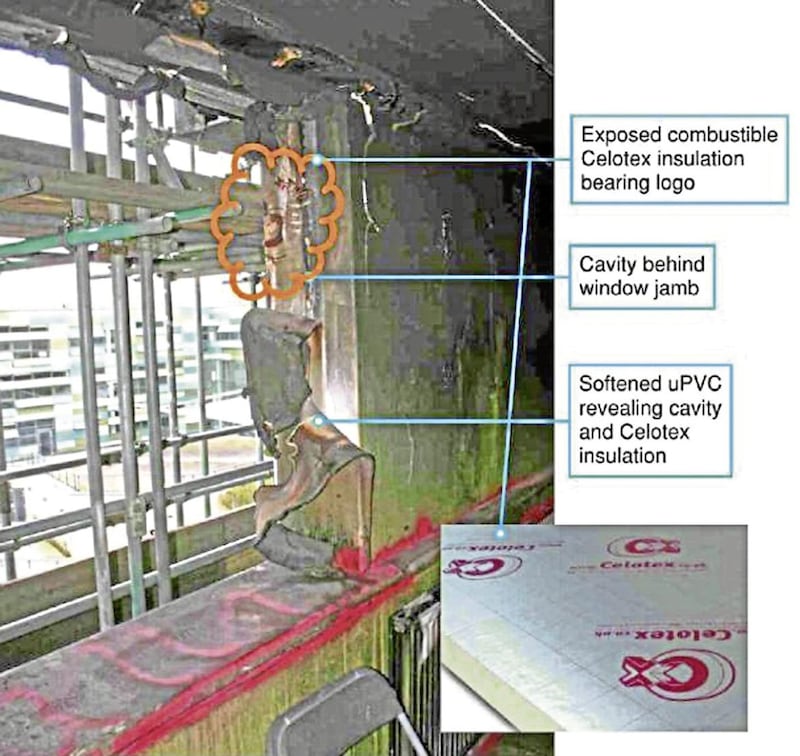
The system was brought in to ventilate the corridors to protect the stairs from smoke likely to escape from a flat in the case of a fire as its occupants fled.
The inquiry has previously heard how the evacuation of residents and the progress of firefighters was hindered as they tried to progress through the smoke-clogged corridors and stairs.
Some people managed to make it out of the burning tower, but later succumbed to the toxic fumes they had inhaled.
PSB said it was satisfied the smoke control system had been "fully commissioned and compliance with the design specification had been demonstrated" when handed over.
However, it said that the design basis assumed in the guidance was a fire starting in and confined to a single location.
Therefore the system that was installed in Grenfell Tower "could only ever operate on one floor at a time and could not have been relied upon to control smoke on more than one floor at a time", it said.
Danny Friedman QC, speaking on behalf of a group of law firms representing survivors and the bereaved, said they were coming to this inquiry in a "calm rage".
He said the inquiry would examine how a local authority "instigated and oversaw a refurbishment of a social housing high rise tower block in such a way as to render it a death trap".
Some people warned it would happen but they were "fobbed off", he said.
"Seventy-two people died. Those who escaped owe their lives primarily to chance rather than risk assessment and contingency planning by either the council or the fire brigade. The people you are coming to know have been left to build something out of nothing, and one of the places for them to do so is here."
Victims contacted the emergency services
Addressing inquiry chairman Sir Martin Moore-Bick, Mr Friedman said: "Sir, you have had the experience of witnessing the bereaved and survivors tell their stories over the previous two weeks.
"And so, perhaps more than any other judge who has started an inquiry in modern times, you know that what has gone on here makes it inevitable, justifiable and reasonable that trust in government, industry and firefighting requires restoration.
"Trust can only begin to be restored through a fearless process of publicly conducted listening, learning and truth telling that inquiries of this nature are able to achieve."
Mr Friedman set out where the victims in the tower were found, some of whom had told emergency services of their rapidly worsening situation.
"We already know that there were a number of elderly people who lived on these upper floors, often with mobility issues which gave rise to specific legal duties to protect who could not have escaped themselves."
A 999 call from Mariem Elgwahry at 1.30am told authorities that families had already started to take shelter on the top floor. Fire had begun to penetrate her flat and the roof door was locked, according to the lawyer.
Upsetting calls were made from the top floor at around 2am, including from Jessica Urbano Ramirez, (12), who died.
These were "important" as they "indicated how quickly the top of the building had been compromised by smoke".
Lost opportunities to rescue victims
Maria de Pilar Burton was rescued by the firefighters from the 19th floor with her husband Nicholas.
"Pily was one of three people in the building that suffered from some form of dementia or Alzheimer's. One died at the scene, Pily died after six months and we know another family who have been made homeless with the added burden that one of their number suffers from the disease."
He set out several "lost" opportunities to evacuate floors where residents died.
Of the 14th floor, he said: "All of these people were advised to congregate in one of these flats and stay put rather than initiating an evacuation to get the group of them down the stairs."
Stephanie Barwise QC said a "disaster of this scale arising from what started and should have remained a kitchen fire suggests failures at every level of design and construction of the refurbishment".
"Of the six commonly recognised layers of protection against fire – namely prevention, detection, evacuation, suppression, compartmentation and the resistance of the structure to the fire – at Grenfell Tower, five of those layers failed.
"That the structure survived is testament to its original solid concrete, virtually incombustible construction," she said.
The flames would have been elongated by five to 10 times when they entered the cavity of the external cladding systems, as they sought oxygen and fuel, Ms Barwise said.
"That extension of five to 10 times is exactly what Professor Bisby considers happened in the 14 columns in Grenfell Tower," she said of an expert report.
Cladding 'woefully low' standard
Quoting Dr Barbara Lane's expert report, Ms Barwise described the insulation in the cladding as the lowest class and therefore "woefully low" in relation to the required standard.
Gaps in the windows were plugged with a material derived from crude oil – "the perfect medium for flame spread at the edge of the window".
"The combination of this highly combustible material and omissions of cavity barriers amounts to a collection of catastrophic failures in construction safety."
Ms Barwise said: "One of the repeated themes of the last fortnight was how many bereaved and survivors have so many unanswered questions and a desperate need for answers.
"Although they are the ones with the greatest right to know, the general public and the construction industry also desperately need those answers."
Ms Barwise said regulations stipulate that works carried out must not make a building less compliant than it previously was, which is called a "material alteration".
"We say, based on Dr Lane's report, that the entirety of the cladding constituted a material alteration, since, as it stood before the refurbishment, Grenfell was constructed of virtually incombustible concrete.
"It was however covered by the polyethylene cladding now openly described by some in the industry as petrol."
Cladding helped spread of fire
Ms Barwise said the cladding system had "patently" promoted rather than resisted fire spread.
She added: "Our understanding is that the ignition of the polyethylene within the cladding panel produces a flaming reaction more quickly than dropping a match into a barrel of petrol."
Ms Barwise said: "Since the turn of the century, both internationally and in the UK, fires involving external cladding systems have become the archetypal form of mass fire disaster.
"This fact put construction and fire engineering professionals on notice of the imperative to develop their risk assessment systems accordingly, and also ought to have informed London Fire Brigade contingency planning."
Mr Friedman said the evacuation had been hindered by the "stay put" policy and then by the over-deployment of firefighters and equipment that crowded the narrow stairwell - the sole escape route.
He said statements from more than 250 firefighters had revealed a lack of experience of a fire of Grenfell's scale and a lack of training in the event that one might occur.
They also showed significant communication problems and a lack of training for 999 call operators in the event that a "stay put" policy was abandoned.
He said: "The near-universal view of those witnesses is that this was a fire utterly beyond their professional experience. But it is also clear that it was a fire beyond their training or indeed the London Fire Brigade's operational contemplation. We say it should not have been.
"And in that recognition of systemic failure of foresight, the inquiry can join this and other fire brigades in remedying what is a violation of the state's responsibility to have training and policy in place that is fit for responding to foreseeable risk to life in cladding fires of this nature."
Fire 'could not be fought'
Mr Friedman said this posed a fundamental question: "Did the LFB waste limited temporal and spatial opportunities in trying to fight a fire that could not be fought, rather than immediately prioritising evacuation to save lives?"
Mr Friedman said a number of firefighter witnesses had "emphatically queried the logic" of the "stay put" advice.
The advice was withdrawn shortly before 2.47am.
A deputy assistant commissioner came to the conclusion at roughly the same time at the control room in Stratford, "triggered at least in part by turning on the television and viewing the fire on Sky News", Mr Friedman said.
Mr Friedman added: "This inquiry is in some ways a tragic review of what would have been discovered and perhaps prevented if the relationship between the the TMO, the council and its tenants and leaseholders had been different and had been conducted as a relationship of equals.
"In the end, the Grenfell Tower fire is an example writ large of how inequalities of political, legal and economic power can kill people."
Mr Stein said: "The term corporate or corporates tend to avoid the fact that these companies are run by people and it was people who made the decisions and caused the injuries."
The Tenant Management Organisation (TMO) which ran Grenfell Tower was also criticised by Mr Stein.
He said: "The TMO say this, 'Why combustible cladding was used on Grenfell Tower is something this inquiry will have to consider'. As the commercial client, it is, we suggest, extraordinary that their opening statement suggests that the TMO is waiting for the inquiry to tell it why it wrapped Grenfell Tower in combustible material.
"The TMO was not a small management organisation - they managed 10,000 homes."
Cost-cutting 'led to the disaster'
At the close of his speech, he said "people should not have to put their lives in the hands of contractors such like Rydon and their sub-contractors".
A cost-cutting attitude among those working on the refurbishment of Grenfell Tower led to the disaster, Sam Stein QC, also representing the bereaved and survivors, said.
He told the hearing: "It was the decision by Kensington and Chelsea, the local authority, the TMO and its contractor to try to refurbish on the cheap that led to this devastation and this desire."
On the industry's persistence in using the type of material used on Grenfell Tower, he said: "Has this failure to deal with dangerous cladding something to do with serial incompetence or had industry become too close to government?
"Remember that the Celotex director Rob Warren made clear on the company website that they were working inside government to influence policy and regulation of industry."
A guide of how a fire could spread through Celotex material was removed from its website after the disaster last June, he said.
The fire brigade should have put the stay put policy in the tower "under urgent, serious consideration almost from the outset", said Pete Weatherby QC, representing survivors and bereaved.
At 1.12am the incident commander saw the cladding was burning "like magnesium... sparking and spitting" and said it was "making me feel uncomfortable", Mr Weatherby told the inquiry. Between 1.16am and 1.20am members of the public could be heard in footage of the tower yelling "get out of the tower" and "people are going to die", he continued.
Fire 'out of control'
Furthermore, he said, 999 calls between 1.20am and 1.30am indicated the flames were on the tower and by 1.28am almost at the top.
"Of course, the people shouting were untrained members of the public but it was patently clear by 1.15am that the fire was out of control, travelling at frightening speed and had gone well beyond the compartment of origin."
He questioned whether, given the clear situation, the incident commander or those who came after him carried out a dynamic risk assessment to change the advice to residents.
"It is clear from what we know now that it should have been under urgent, serious consideration almost from the outset."
He later added: "We reiterate that many firefighters were heroes, we know that the LFB did not start the fire or put up the dangerous materials on the tower. If we're wrong in our assertion that stay put should have given way to full evacuation and that there was a clear requirement for contingency planning, then tell us - avoiding these issues a year on should not be an option."
Mr Weatherby also hit out at the refurbishment firms over their alleged refusal to participate in the inquiry.
He said: "This is a public search for the truth. It is not a game of cat and mouse, nor is it a matter of smoke and mirrors.
"The bereaved and survivors have spent a year in pain waiting to know what had happened - we call on all of the CPs that have yet to do so to set out most fully their position in their statements."
Sir Martin was invited to consider whether RBKC or the TMO were guilty of "institutional racism" by a lawyer representing survivors and bereaved families.
Imran Khan, who once represented the parents of murdered black teenager Stephen Lawrence, said the lessons from the inquiry into his racist killing could be applied to Grenfell. He told the hearing that the current terms of reference should be broadened to see if race, religion or social class played any part in the disaster.
"Our clients believe this is a proper issue to explore," he said. "The evidence that we have seen this far is overwhelmingly in favour of its inclusion as a term of reference."
The Metropolitan Police were found to be "institutionally racist" in their investigation into the death of Stephen in 1993.
Ethnic minorities 'over-represented' in high rise blocks
Mr Khan added: "If we do not ask the question now as to whether race, religion or social class played any part in the events surrounding the fire at Grenfell and answering it with recommendations for the future, we will be putting at risk the lives of thousands, if not hundreds of thousands, of people from black and ethnic minority communities who are over-represented in high-rise blocks across Britain.
"And that was certainly the case as far as Grenfell Tower was concerned."
Descriptions of Grenfell Tower residents in the firefighters' witness statements from the night suggests "unconscious or some conscious racism", Mr Khan said.
He said those in the block from black or minority backgrounds were not described by their clothes or features, but ethnic origin.
This included "middle eastern appearance", "of Arabic descent" and a reference to someone of "Tunisian appearance".
Mr Khan asked what someone of "Tunisian appearance" was supposed to look like.
He went on: "The use of such stereotypes including, in one instance, referring to someone as 'foreign', in the statement of the firefighters on the face of it suggests unconscious or some conscious racism.
"If that is the case we simply ask the question - did it have any impact on the way individuals were treated on that night?"
